Tamilnadu State Board New Syllabus Samacheer Kalvi 12th Bio Botany Guide Pdf Chapter 3 Chromosomal Basis of Inheritance Text Book Back Questions and Answers, Notes.
Tamilnadu Samacheer Kalvi 12th Bio Botany Solutions Chapter 3 Chromosomal Basis of Inheritance
12th Bio Botany Guide Chromosomal Basis of Inheritance Text Book Back Questions and Answers
![]()
I. Choose the correct answer
Question 1.
An allohexaploidy contains
a) Six different genomes
b) Six copies of three different genomes
c) Two copies of three different genomes
d) Six copies of one genome
Answer:
c) Two copies of three different genomes
Question 2.
The A and B genes are 10 cM apart on a chromosome. If an AB/ab heterozygote is test crossed to ab/ab, how many of each progeny class would you expect out of 100 total progeny?
a) 25 AB, 25 ab, 25 Ab, 25 aB
b) 10 AB,10 ab
c) 45 AB, 45 ab
d) 45 AB, 45 ab, 5 Ab, 5aB
Answer:
c) 45 AB, 45 ab
![]()
Question 3.
Match list I with list II
| List I | List II |
| A. A pair of chromosomes extra with diploid | i. monosomy |
| B. One chromosome extra to the diploid | ii tetrasomy |
| C. One chromosome loses from diploid | iii trisomy |
| D. Two individual chromosomes lose from diploid | iv double monosomy |
Question 4.
Which of the following sentences are correct?
1. The offspring exhibit only parental combinations due to incomplete linkage
2. The linked genes exhibit some crossing over in complete linkage
3. The separation of two linked genes are possible in incomplete linkage
4. Crossing over is absent in complete linkage
a) 1 and 2
b) 2 and 3
c) 3 and 4
d) 1 and 4
Answer:
c) 3 and 4
![]()
Question 5.
Accurate mapping of genes can be done by three point test cross because increases
a) Possibility of single cross over
b) Possibility of double cross over
c) Possibility of multiple cross over
d) Possibility of recombination frequency
Answer:
b) Possibility of double cross over
Question 6.
Due to incomplete linkage in maize, the ratio of parental and recombinants are
a) 50:50
b) 7:1:1:7
c) 96.4: 3.6
d) 1:7:7:1
Answer:
b) 7:1:1:7
Question 7.
Genes G S L H are located on same chromosome. The recombination percentage is between L and G isT5%, S and L is 50%, H and S are 20%. The correct order of genes is
a) GHSL
b) SHGL
c) SGHL
d) HSLG
Answer:
c) SGHL
![]()
Question 8.
The point mutation sequence for transition, transition, transversion and transversion in DNA are
a) A to T, T to A, C to G and G to C
b) A to G, C to T, C to G and T to A
c) C to G, A to G, T to A and G to A
d) G to C, A to T, T to A and C to G
Answer:
b) A to G, C to T, C to G and T to A
Question 9.
If haploid number in a cell is 18. The double monosomic and trisomic number will be
a) 35 and 37
b) 34 and 38
c) 37 and 35
d) 17 and 19
Answer:
a) 35 and 37
Question 10.
Changing the codon AGC to AGA represents
a) missense mutation
b) nonsense mutation
c) frameshift mutation
d) deletion mutation
Answer:
a) missense mutation
![]()
Question 11.
Assertion (A): Gamma rays are generally use to induce mutation in wheat varieties.
Reason (R): Because they carry lower energy to non-ionize electrons from atom
a) A is correct. R is correct explanation of A
b) A is correct. R is not correct explanation of A
c) A is correct. R is wrong explanation of A
d) A and R is wrong
Answer:
c) A is correct. R is wrong explanation of A
Question 12.
How many map units separate two alleles A and B if the recombination frequency is 0.09?
a) 900 cM
b) 90 cM
c) 9 cM
d) 0.9 cM
Answer:
c) 9 cM
![]()
Question 13.
When two different genes came from same parent they tend to remain together.
i) What is the name of this phenomenon?
ii) Draw the cross with suitable example.
iii) Write the observed phenotypic ratio.
Answer:
i) The name of this phenomenon is known as Linkage.
This is reported in Sweet pea Lathyrus odoratus by Willium Bateson & Reginald C Punnet in 1906.
Genes for Purple colour and Long pollen grain were found close together in the same homologous pair of chromosomes – They do not assort independently and this condition is known as linkage.
Question 14.
If you cross dominant genotype PV/PV male Drosophila with double recessive female and obtain FI hybrid. Now you cross FI male with double recessive female,
i) What type of linkage is seen?
ii) Draw the cross with correct genotype.
iii) What is the possible genotype in F2 generation?
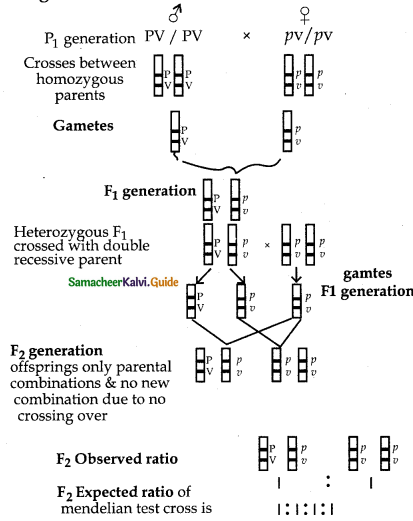
![]()
Question 15.
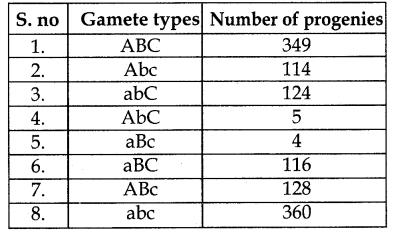
i) What is the name of this test cross?
ii) How will you construct gene mapping from the above given data?
iii) Find out the correct order of genes.
Answer:
i) It is three point test cross – It refers to analysing the inheritance, patterns of three alleles by crossing a triple recessive herterozygote with a triple recessive homozygote.
ii) The relative distance between the three alleles & the order in which they are located can be determined with the help of frequency of recombination between them.
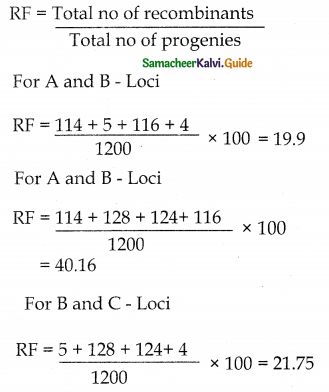
All the loci are linked because all the RF values are considerable less then 50%. In AC loci show highest RF value, they must be farthest apart. There fore the B locus must lie between them. The order of genes should be abc. A genetic map can be drawn.

A final point note that two small map distances. 19.9 m.u and 21.75 m.u is add up to 41.95 m.u which is greater then 40.16 m.u the stance calculated for 1 and g. We must identify the two least number of progenius (totalling 8) in relation to recombination of AC . These two least progenius are double cross over. The two least progenies not only counted once should have count each of them twice because each represents a double recombinant progeny. Hence, We can correct the value adding the number 114 + 125 + 116 + 128 + 5 + 14 + 4 = 500 of the total 1200 this number exactly 41.65% which is identical with the same of two component values.
The test cross parental combination can be rewritten as follows.
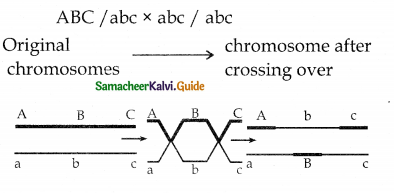
Gene order showing double recombinant.
![]()
Question 16.
What is the difference between missense and nonsense mutation?
Answer:
Mis-sense Mutation:
The mutation where the codon for one amino acid is changed into a codon for another amino acid is called Missense or non-synonymous mutations.
Non-sense Mutation:
The mutations where the codon for one amino acid is changed into a termination or stop codon is called Nonsense mutation.
Question 17.

From the above figure identify the type of mutation and explain it.
Answer:
- It is a change in the arrangement of gene loci,
- Here the duplicated segment is located immediately aftear the normal segment but the gene sepuence order will be reversed – (Paracentric inversion)
Question 18.
Write the salient features of Sutton and Boveri concept.
Answer:
Salient features of the chromosomal theory of inheritance:
- Somatic cells of organisms are derived from the zygote by repeated cell division (mitosis). These consist of two identical sets of chromosomes. One set is received from female parent (maternal) and the other from male parent (paternal). These two chromosomes constitute the homologous pair.
- Chromosomes retain their structural uniqueness and individuality throughout the life cycle of an organism.
- Each chromosome carries specific determiners or Mendelian factors which are now termed as genes.
- The behaviour of chromosomes during the gamete formation (meiosis) provides evidence to the fact that genes or factors are located on chromosomes.
![]()
Question 19.
Explain the mechanism of crossing over.
Answer:
Crossing Over – it is a very significant biological process
It is a precise one with several stages

i) Synapsis:
During zygotene – of prophase. I of meiosis I the homologous chromosomes come and align side by side known as – bivalents.
This pairing – is known as synapsis or syndesis.
Types of synapsis

ii) Tetrad Formation:
Each homologous chromosome of – a bivalent begin to form two identical sister chromatids – held together by a centromere.
Each bivalent has 4 chromatids – (tetrad stage),
iii) Cross Over:
At pachytene stage cross over occur. The points of contact at one or more points between non-sister chromatids is called Chiasmata.
Crossing over is exchange of corresponding segments occur, in the chiasma region.
Synaptonemal Complex (SC)
The highly organised structure of filaments called SC – facilitate chiasma formation.
SC formation & chiasma formation – is absent in Drosophila
Terminalisation:
After crossing over, chiasma starts to moving towards the terminal end of chromatids is known as terminalisation. Complete separation of homologous chromosomes occurs after terminalization.
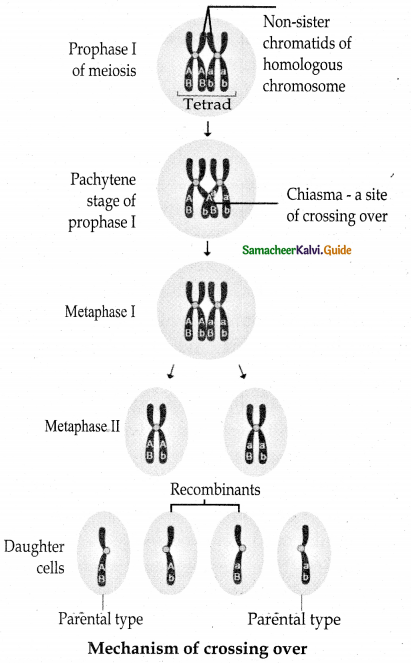
![]()
Question 20.
Write the steps involved in molecular mechanism of DNA recombination with diagram.
Answer:
Proposed by Robin Holliday in 1964
Steps:
- Homologous DNA molecules are paired side by side with their duplicated copies of DMAs
- One strand of both DNAs cut in one place by the enzyme endonuclease.
- The cut strands cross and join the homologous strands – Holliday junction.
- Holliday junction migrates away from the original site, a process called branch migration, as a result heteroduplex region is formed.
- DNA strands may cut along through the vertical (V) line or horizontal (H) line.
- The vertical cut will result in heteroduplexes with recombinants.
- The horizontal cut will result in heteroduplex with non recombinants.
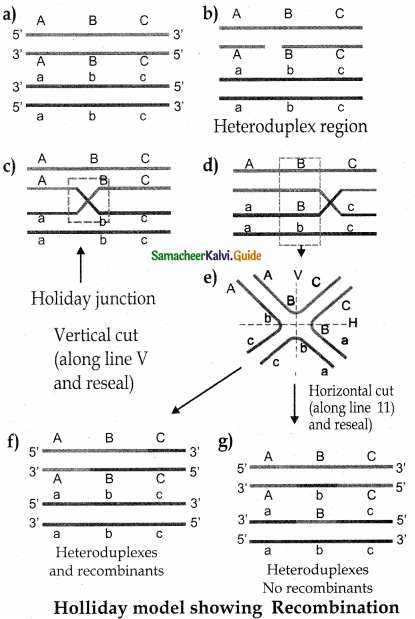
![]()
Question 21.
How is Nicotiana exhibit self¬incompatibility? Explain its mechanism.
Answer:
In Nicotiana self sterility or self-incompatibility is due to multiple alleles.
The pollen from a plant is unable to germinate on its own stigma – and no fertilization.
The gene for self incompatibility can be – ‘S’ which has allelic series S1, S2, S3, S4 & S5.
Cross-fertilizing tobacco – were not always homozygous as S1S1 or S2S2, but heterozygous
Crosses between different S1S2 plants, pollen tube did not develop normally.
But effective – development observed when cross was made with other than S1S2 Eg. S3S4.
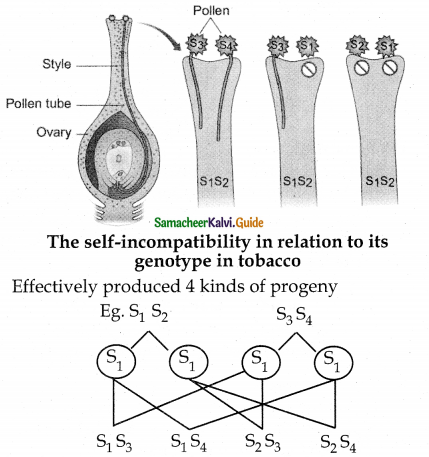
Question 22.
How is sex determined in monoecious plants. Write the genes involved in it.
Answer:
Zeamays (maize) – monoecious plant
Made & Female flowers are present on the same plant.
- Terminal inflorescence – arise from tassel bear staminate flowers
- Lateral inflorescence – arise from ear or cob bear pistillate flowers.
- Unisexvality in maize – occurs through selective abortion of ear florets and pistils in tassel florets.
- The allele for barren plant (ba)- when homozygous makes the stalk staminate (eliminating silk and ears)
- The allele for tassel seed (ts) – transforms tassel into a pistillate structure (no pollen produced)
- Most of these mutations are shown to be defects in Gibberellins biosynthesis.
- Gibbercilins play an important role in the suppression of stamens in florets on the ears.
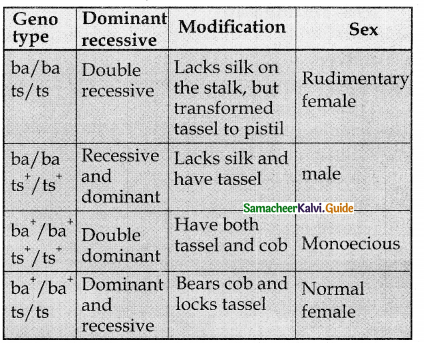
![]()
Question 23.
What is gene mapping? Write its uses.
Answer:
The diagrammatic representation of the position of genes and related distances between the adjacent genes is called genetic mapping. It is directly proportional to the frequency of recombination between them. It is also called a linkage map.
Uses of genetic mapping:
- It is used to determine gene order, identify the locus of a gene and calculate the distances between genes.
- They are useful in predicting the results of dihybrid and trihybrid crosses.
- It allows the geneticists to understand the overall genetic complexity of the particular organism.
Question 24.
Draw the diagram of different types of aneuploidy.
Answer:
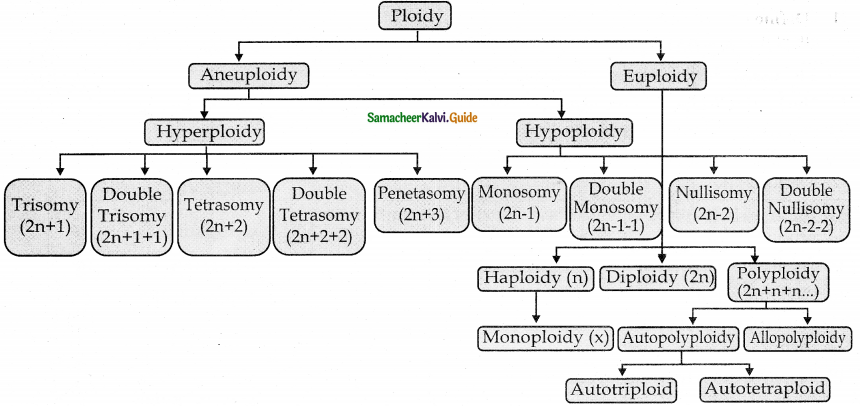
Question 25.
Mention the name of man-made cereal. How it is formed?
Answer:
- Tetraploidy: Crosses between diploid wheat and rye.
- Hexaploidy: Crosses between tetraploid wheat Triticum durum (macaroni wheat) and rye.
- Octoploidy: Crosses between hexaploid wheat T. aestivum (bread wheat) and rye. Hexaploidy Triticale hybrid plants
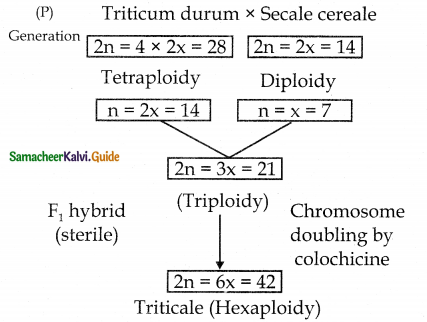
![]()
12th Bio Botany Guide Chromosomal Basis of Inheritance Additional Important Questions and Answers
I. Fill in the blanks
1. The scientists who independently rediscovered mendelian works were
Answer:
De Vries, Correns & Tschermak
2. The worm-shaped cells formed during cell division are called in the earlier period as
Answer:
Chromosomes
3. Who postulated that the chromosomes of a cell are responsible for transferring heredity
Answer:
Wilhelm Roux (1883)
4. ……………………… was the first to find out physical mutagen in Drosophila
Answer:
Muller (1927)
5. ………………………used X-rays for the first time to induce mutation in the fruit fly
Answer:
H.J. Muller
![]()
6. Induced mutations are planted was reported for the first time by
L.J. Stadler
7. Chemical mutagenesis was first reported by
Answer:
Auerback (1944)
8. Double nullisomy is
Answer:
2n-2-2
9. Trisomis were first reported by Blakeslee in
Datura Stramonium
10. All possible tetrasomics are available in ……………………… plant
Answer:
Wheat
11. The kind of Aneuploid are usually lethal are
Answer:
Nullisomy
![]()
12. The alkaloid used to induce polyploidy is
Answer:
Colchicine
13. Raphano brassicas the sterile hybrid of Radish & Cabbage was produced by
Answer:
G.D. Karpechenko (1927)
14. The cross between hexaploid wheat Triticum aestivum and rye produced is a
Answer:
Octoploidy
15. Colchicine is extracted from the root and corms of
Answer:
Colchicum autumnale
16. Who first reported duplication in drosophila
Answer:
Bridges (1919)
17. In which types of cells chromosomal aberration is commonly found?
Answer:
Cancer cells
![]()
18. Recombination frequencies are the same for
Answer:
CIS and trans heterozygotes
19. The map distance between gene A and B is 3 units between B & C is 10 units and between C & A is 7 units – the order of genes in a linkage map constructed on the about would perhaps be
Answer:
B-A-C
20. The percentage of crossing over will be more if
Answer:
Linked genes are located apart from each other
21. A point mutation that changes an amino acid coding codon into a stop codon, prematurely terminating synthesis of the encoded protein ………………………
Answer:
Nonsense mutation
22. Single base change in DNA is known as ………………………
Answer:
Point mutation
![]()
23. Genetic change in a non-sex cell is known as
Answer:
Somatic mulalion
24. A duplicated DNA sequence next to the original sequence is known as
Answer:
Tandem duplication
25. A missing sequence of DNA or part of a chromosome
Answer:
Deletion mutation
26. Mutation that alters the genes reading frame is known as
Answer:
Frame shift mutation
27. A single base change mutation that alters and amino acid ………………………
Answer:
Missense
28. A substance that changes, adds, or deletes a DNA base
Answer:
Multagen
![]()
29. The mutation that introduces a section of aminoacids not normally found is known as ………………………
Answer:
Frame shift mutation
30. A mutation that changes an adenine to guanine is an example of a ………………………
Answer:
transition
31. A point mutation that has no obvious effect at all on the phenotype is called a ……………………… mutation
Answer:
silent
32. A point mutation that changes a codon specifying an amino acid into a stop codon is called a ………………………
Answer:
Non sense mutation
33. Changing the codon AGC to AGA represents ……………………… of a point mutation
Answer:
missense
34. A point multation that alters a codon so that the encoded aminoacid is substituted with another is called a ………………………mutation
Answer:
missense
![]()
35. A ………………………mutation occurs during the DNA replication that precedes meiosis. while a ……………………… mutation occurs during the DNA replication that preceeds mitosis.
Answer:
germline, somatic
36. A mutation that introduction of section of aminoacids not normally found is ………………………
Answer:
Frame shift mutation.
37. A point mutation altering a purine to pyrimidine or vice versa is ………………………
Answer:
transversion
38. A spontaneous mutation usually originates as an error in ………………………
Answer:
DNA replication
39. The codon for leucine is CUC. How many different aminoacids could possibly result from a single base substitution
Answer:
7
40. How may map units separate two alleles if the recombination frequency is o.o7?
Answer:
7cM
41. In a population of 1000 individuals 360 belong to genotype AA. 480 to Aa and the remaining 160 to aa – Based on the data, the frequency of allela A in the population is
Answer:
0.7
![]()
II. Find out the incorrect statement
Question 43.
Which one of the following is incorrect regarding chromosomal behaviour during cell division?
a) The alleles of a genotype are found in the some locus of a homologous chromosome
b) In the S phase of meiotic interphase each chromosome replicates forming two copies of each allele, one on each chromatid.
c) The Homologus chromosomes segregate in metaphase I, thereby separating two different alleles.
d) In anaphase II of meiosis separation of sister chromatid of homologous chromosomes takes place.
Answer:
c) The Homologus chromosomes segregate in metaphase I, thereby separating two different alleles.
Question 44.
a) 94% of all flowering plants are sexually monomorphic
b) When three or more allelic forms of a gense occupy the same locus in given pair of homologous chromosome they are known as Multiple alleles
c) The mutation that result in the change of one
codon of an aminoacid changed into codon of another amino acid is known as Frame shift mutation.
d) Muller (1928) first time used x-rays to induce mutation in Drosophila
Answer:
c) The mutation that result in the change of one codon of an aminoacid changed into codon of another amino acid is known as Frame shift mutation.
![]()
Question 45.
Which of the following statement is not correct of two genes that show 50% recombination frequency?
a) The genes may be on different chromosomes
b) The genes are tightly linked
c) The genes show independent assortment
d) If the genes are present on the same chromosome, they undergo more than one crossover in every meiosis.
Answer:
d) If the genes are present on the same chromosome, they undergo more than one crossover in every meiosis.
Question 46.
a) Selfing of monosomic plants produce nullisomics.
b) In a true diploid both the monoploid and haploid chromosome number are same.
c) An Auto triploids can be produced artificially by crossing between haploid and a diploid.
d) An increase in the number of chromosome
sets has been an important factor in the origin of new plant species.
Answer:
c) An Auto triploids can be produced artificially by crossing between haploid and a diploid.
![]()
III. Match the following
| I | II |
| 1. Pentisomy | 1. 2n – 2 |
| 2. Double monosamy | 2. 2n + 1 |
| 3. Nullisorny | 3. 2n – 1 – 1 |
| 4. Trisomy | 4. 2n + 3 |
a) (i) C (ii) D (iii) B (iv) A
b) (i) B (ii) C (iii) D (iv) A
c) (i) C (ii) B (iii) A (iv) D
d) (i) D (ii) C (iii) A (iv) B
Answer
d) (i) D (ii) C (iii) A (iv) B
IV. Choose the correct statement
Question 48.
When red eyed female Drosophila is crossed with white eyed male, the FI offsprings would be
a) Females are with white eye and males are with red eye.
b) Males are with red eye and females are with yellow eye.
c) Both males and females are with red eye
d) Both males and females are with white eye.
Answer:
c) Both males and females are with red eye
![]()
V. Find the Odd man out with reference to Allopolyploidy
Question 49.
a) All organisms which possess two or more basic sets of chromosomes derived from two
different specie’s.
b) They have four or six copies of its own genome – induced by doubling of the diploid species.
c) They can be developed by inter-specific crosses and fertility is restored by chromosome doubling with colchicine treatment.
d) They are formed between closely related species only..
Answer:
b) They have four or six copies of its own genome – induced by doubling of the diploid species.
VI. Find the Odd man out with reference to Altotriploidy
Question 50.
a) Thev can be produced artificially bv crossing between autotetraploid & diploid.
b) They are highly fertile due to large number of gametes.
c) Cultivated triploid bananas are seedless having larger fruits than diploid.
d) Common doob cross is a natural autotriploid.
Answer:
b) They are highly fertile due to large number of gametes.
VII. Find the Odd man out regarding crossing over
Question 51.
a) It occur in germinal cells during gametogenesis.
b) Take place during Pachytene state of prophase I of meiosis..
c) It is directly proportional to the frequency of recombination between them.
d) It has universal occurrence has great significance.
Answer:
c) It is directly proportional to the frequency of recombination between them.
![]()
VIII. Choose the wrongly matched pair
Question 52.
| I | II |
| a. Crossing over term – coined by | T.H. Morgan |
| b. Concept of gene mapping developed by | A.H. Sturtevant |
| c. Linkage in Lathyrus odoratus is sludied by | Bateson & Punnet |
| d. Widely accepted Model of DNA recombination was 1st proposed by | Robert Koch |
Answer:
d
Question 53.
| a. The condition in which a pair of chromosomes is lost | Nullisomy |
| b. The condition in which one chromosome is lost | Monosomy |
| c The condition in which two chromosome is gained | Tetrasomy |
| d. The condition in which one chromosome is gained | Diplosomy |
Answer:
d
Question 54.
| a. If the chromosome has only one centromere it is known as | Monocentric |
| b. If the inversion include long and short arm of the chromosome does not include centro mere is known as | Paracentric |
| c. If the chromosome has no terminal end – it’s known as | Telocentric |
| d. If inversion include centromere it is known as | Pericentric |
Answer:
c
![]()
IX. Choose the incorrect statement with reference to Deletion
Question 55.
a) Deletions occur due to chemicals, drugs & radiation.
b) On the basis of location of breakage on chromosome it is divided in to Terminal deletion & inter calary deletion
c) Larger deletions have evolutionary significance.
d) Deletions are recorded in Drosophila & Maize
Answer:
c) Larger deletions have evolutionary significance.
Question 56.
How can we reverse the sterility of FI hybrid?
a) Genetic Engineering
b) Protoplasmic fusion
c) Induced Mutation
d) Induced chromosomal aberration
Answer:
d) Induced chromosomal aberration
Question 57.
If haploid number in a cell is 23. The double monosomic and pentasomy number will be
a) 44 and 49
b) 17 and 34
c) 47 and 46
d) 45 and 48
Answer:
a) 44 and 49
Question 58.
Genes located close together on the same chromosome and inherited together represented as
a) linked genes
b) unlinked gene
c) syntenic genes
d) trans genes
Answer:
a) linked genes
![]()
XI. Assertion (A) & Reason (R)
Question 59.
Assertion (A): Arabidopsis plant chromosomes have more repeats of TTT nucleotide sequences in the telomeres.
Reason (R) : Restriction endonuclease enzyme is used in the formation of nucleotide sequence (Telomeres) mui
a) (A) is incorrect, (R) is correct
b) (A) is correct, (R) is the correct explanation (A)
c) (A) is correct, (R) is the incorrect explanation (A)
d) (A) and (R) are wrong.
Answer:
b) (A) is correct, (R) is the correct explanation (A)
Question 60.
Assertion (A) : Linkage and crossing over are two processes that have opposite effects. Reason (R) : Linkage keeps particular genes together but crossing over mixes them.
Answer:
a) If both the Assertion (A) & Reason (R) are true and the reason is a correct explanation of the Assertion. .
Question 61.
Assertion (A) : Increase in temperature increases the rate of mutation.
Reason (R) : While rise in temperature hydrolyses DNA by the restriction endonuclease which degrade Nucleotides.
Answer:
c) Assertion (A) is true but Reason (R) is false
XII. Two Marks
Question 1.
Define chromosome theory of inheritance.
Answer:
It states the Mendelian factors (genes) have specific locus on chromosomes & they carry information from one generation to the next generation.
Question 2.
State the number of chromosomes of the given organism.
Answer:
1) Ophioglossum 2) Arabiodopsis 3) Sugarcane 4) Rice 5) Potato 6) Maize
Answer:
1) -1262;
2) -10;
3) 80;
4) 24;
5) 48;
6) 20
![]()
Question 3.
What are Fossil Genes?
Answer:
- Some junk DNA is made up of pseudogenes, once working but have lost their ability to make proteins.
- They are fossilized parts act as evidence for evolution.
Question 4.
State the works of T.H. Morgan
Answer:
- His works on Drosophila melanogaster – Sex linkage – helped to confirm chromosome theory of heredity.
- He received Nobel prize in Physiology of medicine in 1933 fot it.
- He coined the term crossing over.
Question 5.
What are co-mutagens ?
Answer:
Compounds which are not having own mutagenic properties – but enhance the effects of known mutagens.
Eg. Ascorbic acid – increase the damage caused by hydrogen peroxide.
Caffeine – increase the toxicity of methotrexate.
Question 6.
Differentiate between Euploidy & Aneuploidy
Answer:
Eupoidy :
- Ploidy involving entire sets of chromosomes is known as euploidy
- Triploidy (3x); Tetraploidy (4x); Poly ploidy ( ∞n)
Aneuploidy :
- Here the diploid number is altered either by addition or deletion of one or more chromosomes
- Trisomy; Tetrasomv; Monosomy; Nullisomy (2n+1)(2n+2)(2n-1)(2n-2)
Question 7.
Distinguish between Monoploidy & Haploidy
Answer:
Monoploidy
In Monoploidy the chromosome number is referred as x .
Eg.
Hexaploidy wheat
(2n) = 6 x = 72
haplaid = (n) 36
Monoploidy = x = 12
![]()
Haploidy :
Half the number of somatic chromosomes is referred as gametic chromosome number called haploidy (n) Human of haploid = 23 (n) Wheat of haploid = 36 (n)
Question 8.
Independent assortment & Linkage are alternatives of each other – Discuss
Answer:
|
Independent assortment |
Linkage |
| 1. Genes present in different chromosome they assort independently | Genes present in same chromosome tend to stay together |
| 2. More parental combinations & less new combinations are possible | More parental combinations are possible |
Question 9.
How does the strength and weakness of linkage depend on linked genes?
Answer:
- The strength of linkage increases as the distance between linked genes decreases.
- The linkage becomes weaker with the increase in the distance between genes.
Question 10.
Distinguish between crossing over & Reciprocal Translocation.
Crossing over
- It is legitimate & natural
- Occurs between nonsister chromatids of homologous chromosomes
- Occurs between nonsister chromatids of homologous chromosomes
Reciprocal Translocation :
- It is illegitimate & chromosomal abnormality
- Occurs between non sister chromatids of non homologous chromosomes
- Also play major rome in formation of species
![]()
Question 11.
Distinguish between tetrad & bivalent Tetrad:
Answer:
- During Synapsis homologous chromosomes come together side by side resulting in bivalents
- As the stage during which each bivalent has 4 chromatids & the stage is known as tetrad stage.
Question 12.
Define Recombination.
Answer:
In this segments of DNA one broken and recombined to produce new combination of alleles – known as Recombination.
Question 13.
What is RF (Recombination Frequency)
Answer:
The frequency with which recombination occur is a certain condition

Question 14.
A diploid organism is heterozygous for 4 loci. How many types of gametes cars be produced.
Answer:
The formula 2n is applied – Organism hetr oizy gous f or 4 loci = n = 4.
So 2n = 24 = 2 x 2 x 2 x 2 = 16.
The organism produces 16 types of gametes.
Question 15.
Notes on Colchicine.
Answer:
- Alkaloid, extracted from – root and corms of colchicum autumnale
- In low concentration to the growing lips it induce polyploidy
- It does not affect the source plant due to the presence of Anticolchicine
Question 16.
Write down the significance of ploidy.
Answer:
- Polyploids – More vigorous & more adaptive
- Ornamental flowers – (Autotetraploids) larger flowers – longer flowering duration
- Increase in fresh weight (due to more water content)
- Aneuploids – help to determine the phenotypic effects (loss or gain of different chromosomes
- Allopolyploids of angiosperms play a role in an evolution of plants.
Question 17.
Distinguish between Mendelian disorder & Chromosomal disorder.
Answer:
Mendelian disorder:
Occur due to mutation of single gene & follow the well known Mendelian pattern of inheritance.
Eg. Sickle cell anaemia
Chromosomal disorder :
Chromosomal disorders are produced due to alteration in the number of chromosomes.
Eg. Down syndrome
![]()
Question 18.
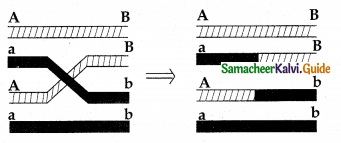
Answer:
a) Which type of crossing over is mentioned in the
above diagram? I h M I
Single cross over
b) Mention the percentage of Recombination Frequency (RF)
RF = 2/4 x 100 = 50%
Question 19.
This is a type of Numerical chromosomal abnormality find it out give a note on it.
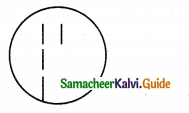
Answer:
- This numerical chromosomal abnormality is known as double monosomy (2n-l-l)
- From a diploid set of chromosome if one chromosomes is lost, the condition is known as monosomy (2n-l)
- If another chromosome is also lost it is known as double monosomy (2n-l-l)
Question 20.
Bring out the difference between Linkage & Crossingover in inheritance
Answer:
Linkage
- It is the tendency of genes in a chromosome to stay close together
- It involves same chromosome of homologous chromosome
- It reduces new gene combinations
- Not very significant in evolution
Crossing over :
- It leads to separation of linked gene
- It involves exchange of segments between nonsister chromatids of homologous chromosome.
- It increases – variability by forming new combinations → lead to formation of new organism
- play important role in evolution
![]()
Question 21.
What is chiasmata?
Answer:
- The non – sister chromatids of homologous pair make a contact at one or more points.
- These points of contact between non-sister chromatids of homologous chromosomes are called chiasmata.
Question 22.
What is multiple alleles?
Answer:
When any of the three or more allelic forms of a gene occupy the same locus in a given pair of homologous chromosomes, they are said be called multiple alleles.
Question 23.
What is monomorphic?
Answer:
- About 94% of all flowering plants have only one type of individual, which produces flowers with male organs (the stamens) and female organs (the carpels).
- Such plants are termed as sexually monomorphic.
Question 24.
What is Dimorphic?
Answer:
Some 6% of flowering plants which have two separate sexes are called dimorphic.
XIII. Three Marks
Question 1.
Differentiate tetrasomy from tetraploidy
Answer:
| Tetrasomy | Tetraploidy |
| Addition of a pair or two individual chromosomes to diploid set is called Tetrasomy. (2n + 2) | Tetraploids have four eopies of its own genome. They can be induced by doubling the chromosomes of a diploid species. |
| (2n + 2 + 2) This condition is known as double tetrasomy | There are two types Auto & Allotetraploidy |
| Eg: wheat | Eg: Grapes, ground nut, potato & coffee |
![]()
Question 2.
Give a tabulation comparing the behaviour of gene & Chromosome
Answer:
| Medelian Factors | Chromosom at behaviour |
| 1. Alleles of a factor occur in pair | Chromosomes occur in pair’s |
| 2. Similar or dissimilar alleles of a factor separate during the gamete formation | The homologous chromosomes during meiosis. |
| 3. Mendelian factors can assort independently | The paired chromosomes can separate independently during meiosis, but the linked genes in the same chromosome normaly do not assort independently. |
Question 3.
The important aspects about the chromosome behaviour during cell devision.
Answer:
- Alleles of a genotype – found in the same locus of a homologous chromosome (A/a)
- In ‘S’ – Phase of meiotic interphase – the replication of chromosome occur – (two copies of each allele (AA/aa) one on each chromatid
- Anaphase II of meiosis, separation of sister chromatids of homologous chromosomes. So each daughter cell (gamete) carries only a single allele of a character (A), (A), (a) and (a)
Question 4.
Write the differences between coupling and Repulsion
Answer:
Coupling
- The two dominant alleles or recessive alleles called repulsion or trans configuration
- It tend to inherit together into same gametes
Repulsion :
- If dominant or recessive alleles are present on occur in the same homologous chromosomes two different but homologous chromosomes.
- If they inherit apart in to different game es are
![]()
Question 5.
Define synapsis.
What are the types of Synapsis
Answer:
- During cygotene stage of prophase I of meiosis I – homologous chromosomes are aligned side by side resulting in a pair called (bivalents).
- This pairing phenomenon is called synapsis or syndesis.
Based on the starting poiring of pairing there are 3 types of synapsisProcentric Proterminal Random Starts from middle Starts from the telomeres Starts from any where
Question 6.
Distinguish between sharbati sonora & Castor Aruna.
Answer:
Sharbati sonora :
- Multant variety of Wheat – approved in 1967
- Sonora 64 (Mexican variety subjected to gamma rays to produce sharbati sonora
- Developed by Dr. M.D. Swaminathan
- Early maturing & high protein content high kneading quality
Castor Aruna :
- Mutant castor variety
- Seeds treated with thermal neutrons
- Early maturing – (120 days instead of 270 dyas) & High yielding.
Question 7.
How do increase in temperature cause mutation?
Answer:
Rise temperature breaks the hydrogen bonds between two DNA nucleotides – & affects the process of replication & transcription.
Question 8.
Distinguish between the impact of ionizing & non ionizing radiation in causing mutation. Ionizing radiation Non Ionizing radiation
Answer:
Ionizing radiation :
- Short wave length and carry enough higher energy to ionize electrons from atoms. They breaks the chromosome & chromatids. Ex. x-rays – gamma rays, alfa rays, beta rays & cosmic rays.
Non Ionizing radiation :
- Longer wave lengths and carry lower energy so they have lover penetrating power used to treat unicellular microbes – spores pollengrains – which have nuclei – near surface membrance. Eg. UV rays
![]()
Question 9.
What is significance of ploidy?
Answer:
- Many polyploids are more vigorous and more adaptable than diploids.
- Many ornamental plants are autotetraploids and have large flower and longer flowering duration than diploids.
- Auto polyploids usually have increase in fresh weight due to more water content.
- Aneuploids are useful to determine the phenotypic effects of loss or gain of different chromosome.
- Many angiosperms are allopolyploids and they play a role in an evolution of plants.
Question 10.
What is chemical mutagens? Give an example?
Answer:
Chemical which include mutation are called mutagens.
Example:
Nitrous oxide alters the nitrogen bases of DNA and disturb the replication and transcription that leads to the formation of incomplete and defective polypeptide during translation.
Question 11.
What is cis configuration (or) coupling?
Answer:
The two dominant alleles or recessive alleles occur in the same homologus chromosomes, tend to inherit together into same gamete are called coupling (or) cis configuration
XIV. Five Marks
Question 1.
Whose works supported the chromosomal theory of heredity? Explain.
Answer:
- T.H. Morgan works on fruit fly supported the chromosomal theory of inheritance.
- The alleles for red or white eye colour are present on the X – chromosome but there is no counter part for this gene on the Y chromosome.
- The genes for yellow body colour and miniature wings are also carried on the X – chromosome.
- By understanding the sex linked inheritance of these characters it is proved that genes are located on the chromosomes.
- Thus T.H. Morgan’s works on Drophila came as a support to the chromosomal theory of inheritance.
![]()
Question 2.
Write down the steps in the Holliday’s hybrid DNA model.
Answer:
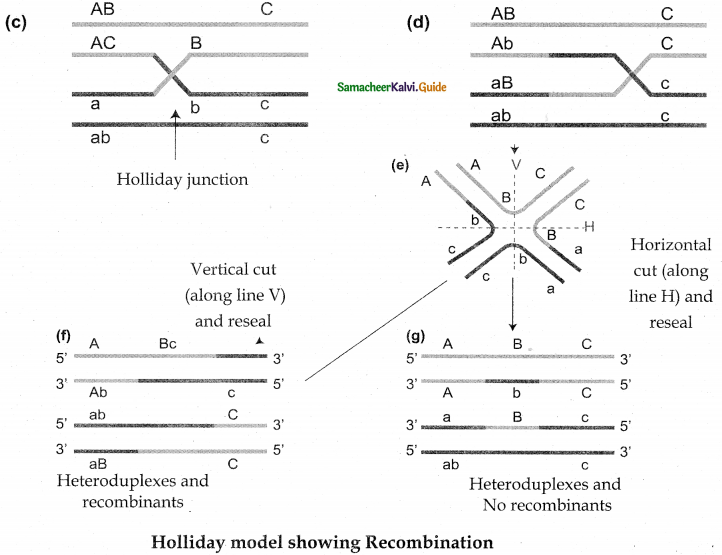
- Homologous DNA molearles are paired side by side with their duplicated copies of DMAs.
- One strand of both DNAs cut in one place by the enzyme endonuclease.
- The cut strands cross & join the homologous strands forming the Holliday junction
- Holliday junction – migrates away from the original site, by branch migration – as a result
heteroduplex region is formed. - DNA strands may cut along the vertical (V) or horizontal (H) line.
- The vertical cut will result in heteroduplexes with recombinants & the Horizontal with non recombinants.
Question 3.
Explain sex determination is Silene latifolia (Melandrium album)
Answer:
- C.E Allen (1917) discovered sex determination in plants.
- Complex precess determined by
- genes
- environment
- hormones
Sex determination silene latifolia – is controlled by 3 distinct regions in a sex chromosome
- Y – Chromosome – determines maleners
- X – Chromosome – specify femaleness
- X & Y – show different segments (I, II, III, IV, & V)
![]()
Question 4.
How do Hawaii explain the sex determination in Papaya
Answer:
- Carica papaya 2n = 36

- The sex chromosomes look like autosomes
- Developed from autosomes
- Y- chromosome carries the genes for male organ
- X- chromosomes bear the gene for female organ development.
Question 5.
Explain sex determination in Sphaerocarpos donnelli. It is also known as Bottle liverwort (Bryophyta)
Answer:
- gametophyte – haploid with 8 chromosome (n).
- The sporophyte – diploid & heterogametic
- Male sfemale gameto phyte – seven autosomes are similar.
- In female 8th chromosome is X – Larger than the seven autosomes.
- In male 8th chromosome is Y – Smaller than the autosomes.
- In sporophyte – contain XY – combinations produces two types of meiospores
- Meiospore with X – produce – female gemetophyte
Question 6.
What are the various types of crossing over.
Answer:
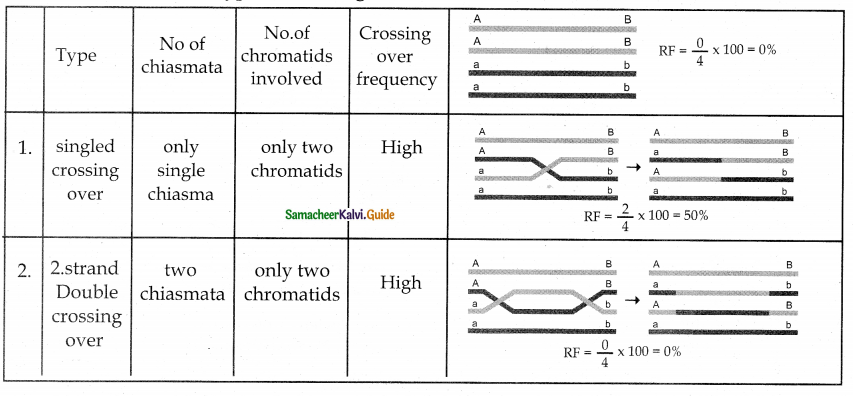
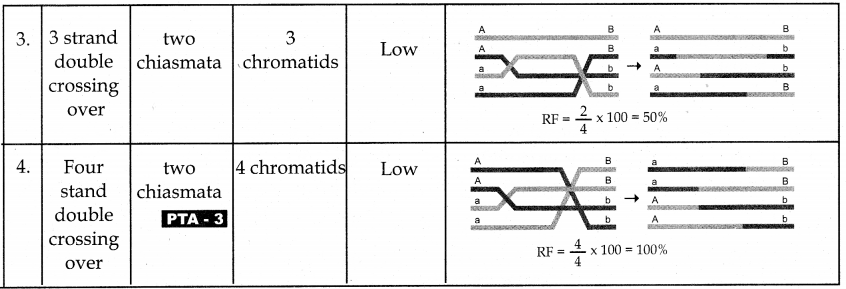
Question 7.
The two loci A/a and D/d are so tightly linked that no recombination is ever observed. If AA dd is crossed to aa DD what phonotypes will be seen in the F2 and in what proportions.
Answer:
Genotypes of the parents are Ad/ Ad x aD x aD – If genes are so tightly linked, the only possible types of gametes produced by parents are
Ad and aD respectively (parental or nonrecombinant gametes)
FI will be all Ad / aD
only types of gametes from each FI can be Ad (50%)oraD(50%)
F2 frequencies can be calculated from these F2 will be Ad/ Ad (1/4i) Ad/ aD (1/2) aD / aD (1/4)
![]()
Question 8.
Classify maj or types of mutations.
Answer:
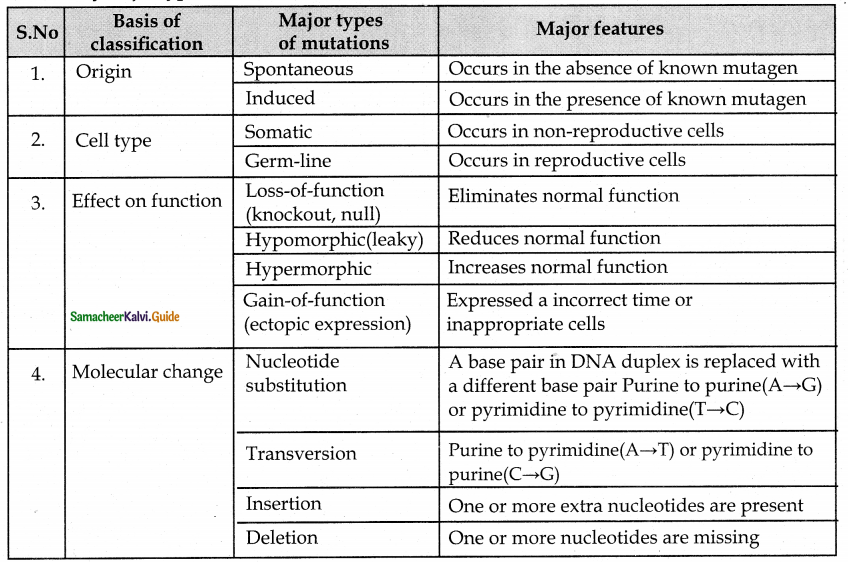

Question 9.
Define point mutation & explain it’s types
Answer:
Definition:
Mutation affecting single base or base pair of DNA
Types:
- Indel mutation : (Base pair insertions or . addition. Addition or deletions of nucleotide
pairs. - Substitution : one base pair is replaced by another
Types – (Two)
- (Purine replaced by Purine)
- Pyrimidine replaced by Pyrimidine
- Transversion purine replaced by pyrimidin or pyridine replaced
Synonymous or silent mutations:
Here change in one codon for an amino acid into another codon for that same amino acid
Missense or Non synonymous mutations
Here the codon for one amino acid is changed in to -a termination or stop codon.
Frameshift mutations.
Additions or deletions of a single base pair of DNA, – changed the reading frame for translation – so there is complete loss of normal protein structure & function.
![]()
Question 10.
Explain how translocation chromosomal aberration is different from crossing over?
Answer:
| crossing over | Translocation |
| It is an exchange of genetic material between homologous chromosomes that occurs during Prophase I of meiosis during gametes formation | It is a genetic abnormality involving the exchange of fragments of genes between non-homologous chromosomes |
| It is a normal event occurring in almost all sexually reproducting organisms. | It is a chromosomal aberration. |
| It often produces recombinations which play important role in evolution. | It rarely produces recominations. |
Question 11.
Explain structural changes in chromosome with reference to changed to changes in the number of gene loci
Answer:
- There are 2 types
- Deletion
- Duplication
Deletion or Deficiency :
- (loss of a portion of chromosome)
- 2 types
- Terminal deletion (break in any one end
- Intercalary deletion (two breaks & reunion of terminal parts leaving the middle.
- > Unpaired loops some times formed known as deficiency loops (during meiotic prophase)
- > Larger deletions may have lethal effect Duplication or Repeat
- > Same order of genes repeated more than once in the same chromosome.
Eg. Drosophila
Duplication
3 types
- Tandem duplication
- Reverse tandem
- Displaced duplication
i) Tandem duplication
Duplicated segment is located immediately after the normal segment in the same order.
ii) Reverse tandem
Duplicated segment, immediately after the normal segment but gene sequence order will be reversed.
ii) Reverse tandem
Duplicated segment away from the normal segment.
Duplication play a maj or role in evolution.
![]()
Question 12.
Explain translocation.
Definition : The transfer of a segment of chromosome to – a non homologous chromosome is called translocation.
Types-3
i) Simple translocation:
Single break in only one chromosome the broken segment gets attached to one end of a non homologous chromosome – (Very rare occurrence)
ii) Shift translocation.
Broken segment of one chromosome gets inserted interstitially in a non homologous chromosome.
iii) Reciprocal translocation.
Mutual exchange of chromosomal segments between two non homologous chromosomes – Illegitimate crossing over)
a) Homozygous translocation.
- Both the chromosomes of two pairs are involved.
- Two homologous of each translocated chromosomes are identical.
b) Heterozygous translocation.
Only me of the chromosome from each pair of two homologous are involved others remain normal.
Question 13.
Consider two hypothetical recessive auto¬somal genes a and b, where a heterozygote is testcrossed to a double homozygous mutant. Predict the phenotypic ratios under the following conditions:
a) a and b are located on separate autosomes.
b) a and b are linked on the same autosome but are so far apart that a crossover occurs between them.
c) a and b are linked on the same autosome but are so close together that a crossover almost never occurs.
Answer:
a) The problem involves an understanding of linkage, crossing over & independent assortment.
F2geno & phenotypic ratio =

b) When crossing over occurs the result in same as the question (a)
F2 geno & phenotypic ratio =

c) When a & b linked with out crossing on the heterozygolic parent can be AB / ab – (cis) or Ab / ab – (tr ans)
However there won’t be any recombinant gametes because no. crossing over occur.
It will produce Ab & aB (50 % of each)
The progeny of test cross will be Ab/ ab&aB/ab